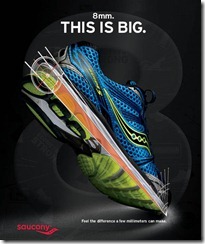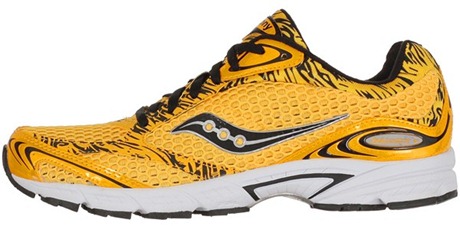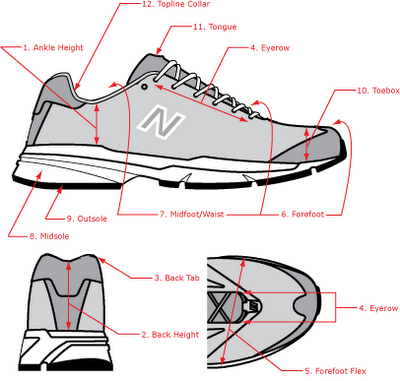 Last Wednesday I was invited along with several other bloggers to participate in a conference call with representatives from Saucony. The group we spoke with included:
Last Wednesday I was invited along with several other bloggers to participate in a conference call with representatives from Saucony. The group we spoke with included:
- Pat O’Malley, Head of Footwear
- Spencer White, Head of our Biomechanics Lab
- Chris Mahoney, Senior Designer
- Sean Robbins, Digital Marketing Manager
I’d spoken to Sean before, and have interacted with him a number of times via email, but this was the first time I’ve actually had contact with the footwear design team from the company. The purpose of the call was for Saucony to have a chance to explain a bit about their plans to reduce 3 of their flagship shoes from a 12mm heel-forefoot drop down to 8mm (the Triumph 9, Guide 5, and Hurricane 14).
I was impressed by how open the folks from Saucony were, and they answered every question we threw at them. I asked if they could give me a bit of history regarding the origin of the 12mm heel-forefoot differential, and if they knew when and why that number was settled upon as standard by the industry. The response was that they had indeed looked into that, but could not find an answer. They indicated that back in the 80’s some of their shoes had even a higher lift, but that it seems that much of the reasoning behind the design standard was simply because that is how it has been done for as long as any of them could remember – in other words, a historical norm with no real scientific basis (and they agreed on the lack of good science supporting it).
Of particular interest relating to the topic of heel lifts in running shoes is the fact that the Saucony folks revealed to us that they intend to abandon the 12mm lift model entirely. If all goes according to the plan they described, all of their traditional 12mm lift shoes will be migrated down to 8mm (not just the three mentioned above). They indicated that the science and their in-house testing supports the move, and feedback from their testers has indicated that people overwhelmingly have preferred a lower drop shoe. They also informed us that the Kinvara is now their number two best selling shoe after the Saucony Ride – they have a ton of consumer data since the Kinvara came out before most other companies started putting out lower drop shoes, and thus their experience tells them that this is the right choice at the right time.
We covered much additional ground in our conversation, but to me this was the biggest news. If they follow through, Saucony will be the first of the big running shoe manufacturers to fully abandon what has until recently been almost an industry standard midsole differential in favor of something less. I give them a lot of credit for having the guts to make changes to their traditional line. It’s a bold move in the current market, and it will be interesting to see how it is received.
What do you think? Wise choice, or big risk?



















I wonder if many will even notice the difference. Oh, sure, folks like you and I will notice, and be glad for the change. But of the general population of runners, how many even know what heel-toe drop is, let alone know why they should care? The upside is that some may slip on their new Hurricane 14s and notice their $TROUBLESOME_BODY_PART doesn’t hurt anymore, or that they run more comfortably, or some other positive outcome.
Risky or wise? Saucony can’t keep Kinvaras on the shelves, and their only stated reason for such high heel lift is “that’s the way we’ve always done it”. I’ll pick “wise” for getting away from the shoes that have been progressively built up over the years with little benefit to show for it.
This is a positive move and I wonder if other majors will follow suit. You briefly touch on this in your post but I am interested if they gave a detailed explanation as to why they settled on 8mm rather than a lower drop shoe.
A couple of things. We talked about this, and they indicated that through customer feedback and wear testing, they’ve found that most people can go from 12mm to 8mm without issue, but from 12mm to 4mm some people start to experience calf soreness, etc. So, they felt that 8mm would be a level to which they could drop the heel without people experiencing major issues due to the change. Secondly, they’ve already filled out the 4mm niche with the Cortana, Kinvara, Mirage, A4, so redundancy makes no sense. Personally, I think that as long as some people spend their entire work day in heeled shoes, there is no reason to fully abandon shoes with a modest heel lift. If everyone was zero drop all of the time, I’d feel differently.
Pete, thanks for the detailed reply. As someone who transitioned slowly from big heeled shoes to now doing all of my running in zero drop shoes I can understand this reasoning. I don’t think the market is ready to abandon shoes with heels just yet but this is a step in the right direction. Cheers, Paul
I wonder what made them settle on 8mm? I doubt there is any science behind that number either. Great to see though. Looking forward to when they move shoes to 4mm and 0mm only.
I read somewhere that Saucony brought in a bunch of testers and they seemed to transition to 8mm fine, but 4mm gave a lot of them lower leg soreness. I thought it was on this blog, but maybe not, since I can’t find it. Anyway, Saucony already offers several 4mm drop shoes (Kinvara, Mirage, Cortana) and a zero drop shoe (Hattori), and there are several other 0-4mm drop shoes on the market from other companies, so 8mm will allow for some variety for different people with differing needs. Just like not everyone wants a 12mm drop, not everyone wants a 4mm or 0mm drop either. 8mm fills a relatively untapped market niche, since it’s currently only populated by lightweight trainers and racing flats.
I doubt most people will notice. Some who do will like the change, and those who don’t still have plenty of other 12mm drop shoes to choose from. I also think Saucony will pick up a lot of people who want to go to a lower drop but do not want to abandon the features offered to them by a traditional trainer. It’s probably a good move on their part, and allows Saucony to remain at the forefont of the more reduced shoes (at least among the big companies) but only time will tell.
That is interesting info on the testing. I realize that a gradual transition is necessary since the shoe companies marketed/forced us into their 12mm lift blunder in the first place. I’m curious to see if years from now all shoes will be low drop. Probably depends on how long Nike holds out.
Nike’s has a few shoes that are lower drop actually. Their Free was one of the earlier shoes marketed as barefoot-like (back in 2006), and I believe both the 3.0 and Run have a 7mm drop. If you count flats, the Streak XC has a 3mm drop and LunarSpider has a 6mm drop.
Just a note, I did read it on this blog! Here’s the comment from Pete: “they indicated that through customer feedback and wear testing, they’ve found that most people can go from 12mm to 8mm without issue, but from 12mm to 4mm some people start to experience calf soreness, etc. So, they felt that 8mm would be a level to which they could drop the heel without people experiencing major issues due to the change.”
I love my Kinvara 2’s, I am a convert from Brooks Adrenalin which I have worn for the last 8 years…
I bought a pair of Kinvara’s a half size down earlier in the summer planning to run sock-less, which worked very well. Need to get a pair for winter a half size up so I can wear socks and have warm feet, at least as much as possible in the New Hampshire winter…
Thanks for your blog and your reviews! They are very helpful!!
As with the variability of runners’ physiology, experience, technique, speeds and distances I think just having the range of differing heel to toe gradients is a huge benefit.
Having reducing heights from the conventional 12s to 10s to 9,8,6,4,2 and 0 are all available now. Not only does this help with transitioning without as much difficulty adapting but just as we question why 12 was ever chosen as a standard we can find what works best for each runner uniquely. Some runners may feel best with the lower the better while others might settle best in an 8 or 6 or….etc.
Saucony is lead a great charge here and it looks like NB is not far behind making some similar moves.
Do I personally think overall shoes should all come down? Yes. But I also think all this choice is allowing for so many runners to start seeing how and what shoe profile could benefit them best.
Now for an evening run in my Hattoris….haha. Thank you Saucony!
Now if they could just fix their forefoot/toe box shape, they’d have some real winners in my book. Good on ’emthe for making this move, though.
Fully agreed. As much as I love the ride of the Kinvara, I find myself running much more in the Minimus due to the much better toe box.
Same here, Robert and David (maybe Saucony is reading these comments)!
I agree as well. While I love Saucony shoes, they would be much better if they had a wider and more rounded toe box.
oh this is a fantastic move!
this drop won’t do anything bad
the sooner the drop goes the better!
although i think slightly lowering the drop is a new kind of gimmick
but i do understand we can’t just go zero drop
I think this is a very smart strategy on Saucony’s part. First off, of your big shoe brands nobody has really tried to own the low-drop space. Everyone, save Nike, is dabbling in the space but nobody is owning it. Saucony is moving to own the space. From a business standpoint it makes a lot of sense to focus on a category where Nike, the market leader, is weak. More people are running than ever before. Marathon participation has never been higher. Saucony is positioning itself to have a unique value proposition among the dozens of running shoes on the wall at your local retailer for all the new runners coming in wanting to know what’s the difference between all those shoes. Aside from the lower drop, this should translate into lighter shoes since less material goes into fabrication. On that note, less material– I’m guessing the uppers will also move more towards the minimal end of the spectrum as well– will reduce manufacturing costs, hence raising Saucony’s margin.
Pete, first, thank you for the dedication you put into your blog, it keeps the rest of us up on what is going on in the world of science and technology in running shoes, not marketing fads…Congrats to Saucony, I think their 8mm drop will be well received and I look forward to more innovation from them in the future. Love the Kinvara!
Just adding that saucony currently offers more 4 mm shoes (other than kinvara mirage or perergine) such as shadow genesis, outlaw, fastwitch.
Good point – they have a broad selection of 4mm shoes, which I think is great.
The Shadow Genesis is a 12mm drop. I emailed Saucony about this as it looked lower, but they confirmed that it is indeed 12mm.
I think this is a great move, (if only our education system could also abandon their addiction to dogmatic practices)!
I am willing to bet that many negative reviews on shopping websites and forums will pop up over the first year of so, but, as far as that goes, the standard consumer typically complains about silly, often arbitrary things. After a settling period following the change, brand loyalty will take over again (as well as the millions of runners who just buy whatever they see other gym-goers wearing) and the company will be in the clear. And we’ll get a win for data-based decision ;)
I think this is a great move (if only our education system could abandon their addiction to dogmatic practices as well)!
I am willing to bet that during the first year or so after this change lots of negative consumer reviews litter the internet. But it is my overwhelming impression that the typical recreational runner/shopper complains about really arbitrary things. No doubt such reviews will not even focus on the new shoes but will gripe about the loss of 4mm, and perhaps their favorite color. Then again, the general populous may not even notice! Anyway, once that adjustment period ends, those who moan will go back to buying whatever they see people at the gym wearing.
In the end it will be a win for not only people, but companies, making data-based decisions! whooot!
-AB
And it’s worth noting, for those who do want to take the zero-drop plunge, Saucony has the Hattori. Although the shoe doesn’t seem to have caught on in any meaningful way, it’s one of my favorites. Easy on, easy off, and cushioned enough to be comfortable for just about as long as you like.
This seems like a good move.. I am on my fifth pair of Kinvaras.. I just re-ordered 2 pairs of Kinvara 1. The Kinvara 2 fits differently, and I don’t run the same in them.
Great post Pete. It sounds like you were able to get some insight on the history of the heel height. Did they have any data on the efficacy of the stability devices in the Guide and Hurricane?
Didn’t ask about that, but I have my thoughts :)
Sent from my iPad
8mm is probably very good choice for the masses, it makes a significant change while not being too tough. Going lower would just lead to sore calves. The shoes to the masses must work for people that have a western shoe tradition. True minimal zero drop shoes would not realistic, you need a special interest to endure six months or so with sore calves, and people buying these kind of shoes just want to run some, not change their lifestyle and get rid of all “high-heeled” shoes in daily life etc.
Exactly.
Sent from my iPad
how exciting! Really looking forward to how this pans out.
Is it a risky move? sure, there are almost certainly going to be loyal saucony customers that find their shoe’s no longer feel like they did … the internet is full of runners complaining about even minor changes introduced in an upgrade this is bound to be noticed and hated by a minority. But is it a risk that will pay off… i think so, many may not even notice the difference, and they are creating a point of difference, and filling a niche that isnt really well served at the moment.
However its unlikely to affect me because unfortunatly all of the saucony shoes i have tried on have a similar problem for me. They narrow across the toes to much. I find it hard to laud them for embracing a more Natural Style of running when their toe boxes seem made for people with pointy feet. My feet arnt Pointy, theyre actually kinda square across the toes….
I do however look foward to the day i try on a pair of saucony’s and say yep.
The saucony rep wrote me the shadow genesis is only 4 mm drop. check also the website: beleiveintherun.com